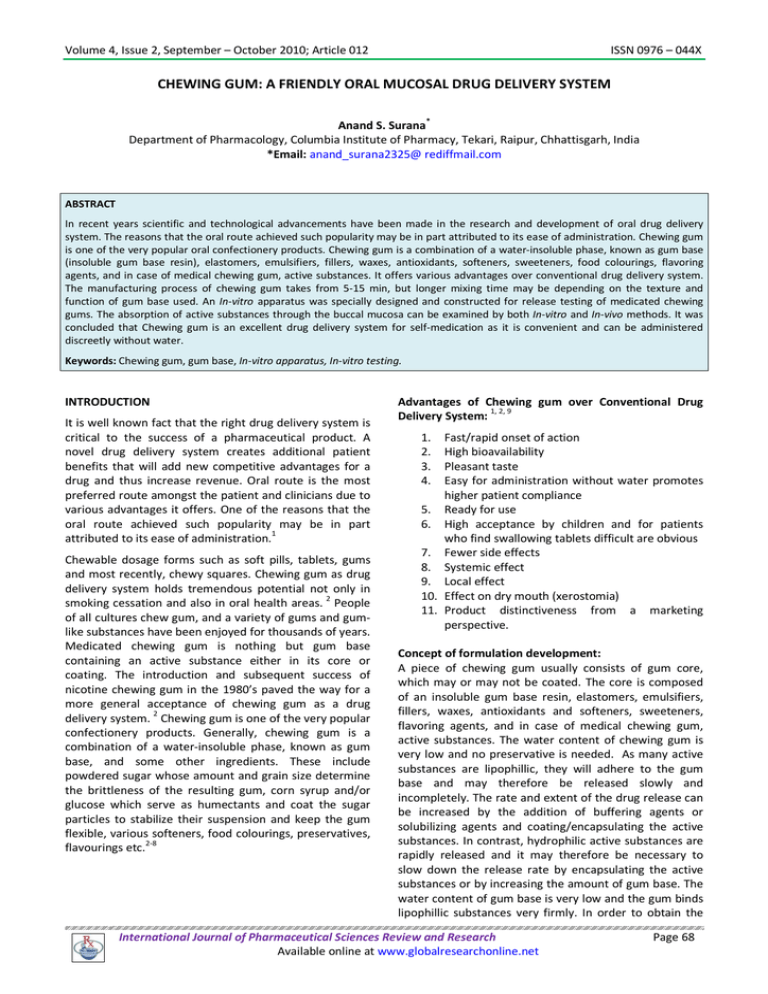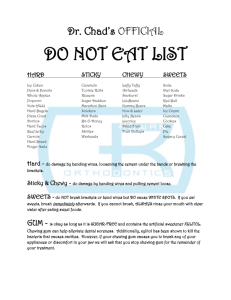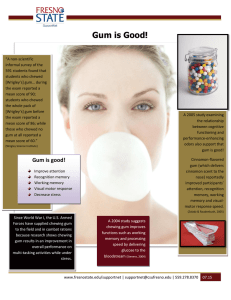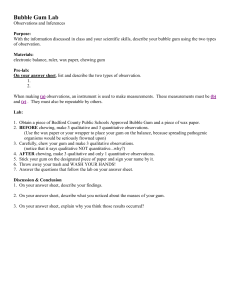Document 13308253
advertisement

Volume 4, Issue 2, September – October 2010; Article 012 ISSN 0976 – 044X CHEWING GUM: A FRIENDLY ORAL MUCOSAL DRUG DELIVERY SYSTEM * Anand S. Surana Department of Pharmacology, Columbia Institute of Pharmacy, Tekari, Raipur, Chhattisgarh, India *Email: anand_surana2325@ rediffmail.com ABSTRACT In recent years scientific and technological advancements have been made in the research and development of oral drug delivery system. The reasons that the oral route achieved such popularity may be in part attributed to its ease of administration. Chewing gum is one of the very popular oral confectionery products. Chewing gum is a combination of a water-insoluble phase, known as gum base (insoluble gum base resin), elastomers, emulsifiers, fillers, waxes, antioxidants, softeners, sweeteners, food colourings, flavoring agents, and in case of medical chewing gum, active substances. It offers various advantages over conventional drug delivery system. The manufacturing process of chewing gum takes from 5-15 min, but longer mixing time may be depending on the texture and function of gum base used. An In-vitro apparatus was specially designed and constructed for release testing of medicated chewing gums. The absorption of active substances through the buccal mucosa can be examined by both In-vitro and In-vivo methods. It was concluded that Chewing gum is an excellent drug delivery system for self-medication as it is convenient and can be administered discreetly without water. Keywords: Chewing gum, gum base, In-vitro apparatus, In-vitro testing. INTRODUCTION It is well known fact that the right drug delivery system is critical to the success of a pharmaceutical product. A novel drug delivery system creates additional patient benefits that will add new competitive advantages for a drug and thus increase revenue. Oral route is the most preferred route amongst the patient and clinicians due to various advantages it offers. One of the reasons that the oral route achieved such popularity may be in part attributed to its ease of administration.1 Chewable dosage forms such as soft pills, tablets, gums and most recently, chewy squares. Chewing gum as drug delivery system holds tremendous potential not only in smoking cessation and also in oral health areas. 2 People of all cultures chew gum, and a variety of gums and gumlike substances have been enjoyed for thousands of years. Medicated chewing gum is nothing but gum base containing an active substance either in its core or coating. The introduction and subsequent success of nicotine chewing gum in the 1980’s paved the way for a more general acceptance of chewing gum as a drug delivery system. 2 Chewing gum is one of the very popular confectionery products. Generally, chewing gum is a combination of a water-insoluble phase, known as gum base, and some other ingredients. These include powdered sugar whose amount and grain size determine the brittleness of the resulting gum, corn syrup and/or glucose which serve as humectants and coat the sugar particles to stabilize their suspension and keep the gum flexible, various softeners, food colourings, preservatives, flavourings etc.2-8 Advantages of Chewing gum over Conventional Drug Delivery System: 1, 2, 9 1. 2. 3. 4. Fast/rapid onset of action High bioavailability Pleasant taste Easy for administration without water promotes higher patient compliance 5. Ready for use 6. High acceptance by children and for patients who find swallowing tablets difficult are obvious 7. Fewer side effects 8. Systemic effect 9. Local effect 10. Effect on dry mouth (xerostomia) 11. Product distinctiveness from a marketing perspective. Concept of formulation development: A piece of chewing gum usually consists of gum core, which may or may not be coated. The core is composed of an insoluble gum base resin, elastomers, emulsifiers, fillers, waxes, antioxidants and softeners, sweeteners, flavoring agents, and in case of medical chewing gum, active substances. The water content of chewing gum is very low and no preservative is needed. As many active substances are lipophillic, they will adhere to the gum base and may therefore be released slowly and incompletely. The rate and extent of the drug release can be increased by the addition of buffering agents or solubilizing agents and coating/encapsulating the active substances. In contrast, hydrophilic active substances are rapidly released and it may therefore be necessary to slow down the release rate by encapsulating the active substances or by increasing the amount of gum base. The water content of gum base is very low and the gum binds lipophillic substances very firmly. In order to obtain the International Journal of Pharmaceutical Sciences Review and Research Available online at www.globalresearchonline.net Page 68 Volume 4, Issue 2, September – October 2010; Article 012 ISSN 0976 – 044X optimal formulation it is possible to decrease the release rate, choose highly lipophilic substances and increase the release rate of lipophillic substances. 9-10 To succeed in the market, a chewing gum formulation must have a pleasant taste and texture. The gum base determines the basic characteristics of the product like the texture, its softness, hardness, elasticity, crumbleness, stickiness, mouthfeel etc. It also determines the release profile of active ingredients and flavors. The apparatus proved to be suitable in product control of commercial batches but also a useful tool in the research and development of medicated chewing gum 16-18 formulations. Formulation: Chewing gum consists basically of a neutral and tasteless masticatory gum base (15-40%) and several nonmasticatory ingredients such as fillers, softeners, sweetening agents, flavouring agents and texture regulating agents.10-14 The main components of medicated chewing gum are shown in Table 1. In addition to above ingredients various additives are also used to improve properties of chewing gum, like plasticizers, elastomers, lipids (soyabil), emulsifiers (lecithin), softeners (partially hydrogenated fatty acids esters, e.g., hydrogenated soybean oil.) and fillers, texture agents (talc), coating and binding agents, film formers, coloring agents etc. Corn syrup keeps the gum flexible and fresh. Xylitol has been investigated to play a significant role in dental caries. 9-16 Manufacturing process: 13-16 A typical process of manufacturing chewing gum is as follows. The gum base would be softened or melted (between 50 and 70°C) and placed in large kettles and ground thoroughly. Then mixture is purified by using a straining apparatus and high speed centrifuges. The flavorings, softeners and sweeteners, mixed with the gum base in machines with strong rotating blades, produce a mass with the consistency of stiff bread dough. The gum mass is sent through a series of rollers, formed into a thin, wide ribbon, lightly coated with powder sugar (to prevent sticking) and scored (cut and broken) into single sticks. The gum is conditioned to increase shelf life. The product is packaged and readied for distribution. The entire procedure takes from 5-15 min, but longer mixing time may be depending on the texture and function of gum 1 base used. In-vitro Apparatus: An apparatus was specially designed and constructed for release testing of medicated chewing gums. The adjustable instrumental settings such as temperature, chewing frequency, chewing time, volume of test medium, distance between the jaws and twisting angle increased the versatility of the apparatus. Selection of the test medium was also an important parameter. Each sample was kneaded mechanically in separate test chambers and the drug release was followed by sampling and HPLC analysis. Different gum formulations were tested and the obtained results demonstrated satisfactory release curves for a variety of formulations and active ingredients. The tested gum formulations include nicotine, meclizine, dimenhydrinate and xylitol. In-vitro testing: The absorption of active substances through the buccal mucosa can be examined by both in vitro and in vivo methods. The most common method utilizes using chamber where excised buccal mucosa (either from human or animal) is placed as a barrier between two chambers. The transport of active substances across the mucosa is measured by withdrawal of samples from each chamber. Porcine oral cavity is recommended, as it is morphologically similar to human oral cavity. 16 Likewise, a human TR146 cell culture model has proven a good in-vitro model for investigating permeability, permeability mechanisms, effects of chemical enhancers, 19 and toxic effects. Applications: 9, 16, 20, 21, 22, 23 1. Dental caries: a. Prevention and cure of oral disease are targets for chewing gum formulations. b. It can control the release rate of active substances providing a prolonged local effect. c. It also re-elevates plaque pH which lowers intensity and frequency of dental caries. d. Fluoride containing gums have been useful in preventing dental caries in children and in adults with xerostomia. e. Chlorhexidine chewing gum can be used to treat gingivitis, periodontitis, oral and pharyngeal infections. f. It can also be used for inhibition of plaque growth. g. Chlorhexidine chewing gum offers numerous flexibility in its formulation as it gives less staining of the teeth and is distributed evenly in the oral cavity. h. The bitter taste of chlorhexidine can be masked quite well in a chewing gum formulation. 2. Systemic therapy: a) Pain- chewing gum can be used in treatment of minor pains, headache and muscular aches. b) Smoking cessation- Chewing gum formulation containing nicotine and lobeline have been clinically tested as aids to smoking cessation. c) Obesity- Active substances like chromium, guaran and caffeine are proved to be efficient in treating obesity. Chromium is claimed to reduce craving for food due to an improved blood-glucose balance. Caffeine and guaran stimulate lipolysis and have a thermogenic effect (increased energy expenditure) and reduce feeling of hunger. d) Other indications- Xerostomia, Allergy, Motion sickness, Acidity, Cold and Cough, Diabetes, Anxiety, etc International Journal of Pharmaceutical Sciences Review and Research Available online at www.globalresearchonline.net Page 69 Volume 4, Issue 2, September – October 2010; Article 012 are all indications for which chewing gum as drug delivery system could be beneficial. Limitations of Chewing gum as Drug Delivery System: 2 Chewing gum has several disadvantages as the drug released into saliva disappears rapidly from the oral cavity because of involuntary swallowing. The concentration of drug in the oral cavity always tends to decrease as a result of salivary dilution. Drug release from chewable formulations has shown to be strongly influenced by the way patient chews the formulation. Administration of such dosage form is restricted to short period of time because the presence of the delivery system in the oral cavity causes disturbance in drinking, eating and speaking. Despite these limitations, chewing gum formulation affords extended delivery period compared to solution and fast dissolving tablets. Commercially available Chewing Gum: Product Drug Nicorette Nicotine Nicotinell Nicotine NiQuitin CQ Nicotine Fluorette Fluoride Vitaflo CHX Chlorhexidine Advanced+ Chlorhexidine HEXIT Chlorhexidine Stay Alert Caffeine Travvell Dimenhydrinate ISSN 0976 – 044X CONCLUSION Chewing gum is an excellent drug delivery system for selfmedication, as it is convenient and can be administered discreetly without water. It offers several advantages compared to chewable tablets, lozenges and other related formulations. Hence in forth coming years it will become a much more common and popular drug delivery system. REFERENCES Chien YW, Novel Drug Delivery Systems, II edition, Revised and expanded, Marcel Dekker, New York, 1992, 139-40. 2. Lieberman HA, Lachman L, Schwartz JB, Pharmaceutical Dosage Forms: Tablets, Vol-I, IInd edition, 1990; 367-415. 3. Sook Wai Wong, Bin Yu, Philip Curran, Weibiao Zhou, Characterising the release of flavour compounds from chewing gum through HS-SPME analysis and mathematical modelling. Food Chemistry. 2009; 114: 852–8 4. Davidson JM, Linforth RS, Hollowood TA, Taylor AJ, Effect of sucrose on the perceived flavour intensity of chewing gum, Journal of Agricultural and Food Chemistry, 1999; 47(10): 4336-40. 5. Lubbers S, Guichard E, The effects of sugars and pectin on flavour release from a fruit pastille model system, Food Chem. 2003; 81(2): 269-73. 6. Matheis G, Flavourings: Production, composition, applications, regulations, Germany, Weinheim: Wiley-VCH. 2007; 437–65. 7. Guichard E, Interactions between pectins and flavour compounds in strawberry jam, In FlavourFood Interactions. ACS Symposium Series. 1996; 118-29. 8. Kersiene M, Adams A, Dubra A, De KN, Leskauskaite D, Interactions between flavour release and rheological properties in model custard desserts: Effect of starch concentration and milk fat, Food Chemistry. 2008; 108(4): 1183-91. 9. Rassing MR, Specialized oral mucosal drug delivery systems: Chewing gums. In: Rathbone, M.J. (Ed.), Oral Muccosal Drug Delivery, Marcel Dekker, New York, 1996; 319-57. Future Trends: Chewing gum not only offers clinical benefits but also is an attractive, discrete and efficient drug delivery system. Nowadays more and more disease can be treated with Novel Drug Delivery Systems. Generally, it takes time for a new drug delivery system to establish itself in the market and gain acceptance and popularity by the patients, however chewing gum is believed to manifest its position as a convenient and advantageous drug delivery system as it meets the high quality standards of pharmaceutical industry and can be formulated to obtain different release profiles of active substances. Finally, in the future, we may see that more and more drugs formulated into chewing gum in preference to other delivery systems to deliver drugs locally to the oral cavity. The reason is simple that the chewing gum delivery system is convenient, easy to administer anywhere, anytime and its pleasant taste increases the product acceptability and patient compliance. nd 1. 10. Cherukuri SR, Friello DR, Ferroti M, Jewell M, D'Amelia RP, Gum base, chewing gum containing same and method, U.S. Patent 4,352,822 (1982). 11. Tessier AM, Nolot P, Delaveau P, Les masticatoires modernes, Md. et Nut.T.XIII, 3, 171 194 (1977). 12. Mackay AM, Clark KW, Witzel F, Schoenholz D, Longlasting flavored chewing gum including chalk-free gum base, U.S. Patent 4,064,274 (1977). International Journal of Pharmaceutical Sciences Review and Research Available online at www.globalresearchonline.net Page 70 Volume 4, Issue 2, September – October 2010; Article 012 13. Song JH, Greenberg MJ, Record DW, Zibell SE, Schnell PG, Gum composition containing dispersed porous beads containing active ingredients and method, U.S. Patent 5,154,927 (1992). 14. Technology/ industry overviews, Chewing as drug delivery system. Food Chemistry. 2009; 114: 852-8. 15. Maggia L, Segale L, Conti S, Ochoa ME, Salini A, Conte U, Preparation and evaluation of release characteristics of 3TabGum, a novel chewing device, Euro J Pharm Sci, 2005; 24: 487-93. 16. Rassing M, Chewing gum as a drug delivery system, Adv Drug Delivery Rev, 1994; 13: 89-121. 17. Kvist LC, Andersson SB, Fors SM, Wennergren B, Berglund J, Apparatus for studying in vitro drug release from medicated chewing gums, Int J of Pharm, 1999; 189: 57–65. ISSN 0976 – 044X medicated chewing gums, J Ana, 2000; 22: 405-11. Pharm and Biomed 19. Nielsen HM, Ph.D. thesis, HCØ Tryk, Copenhagen, DK. (2000). 20. Dalai Kahtani, Chewinggum: trick or treat, The Saudi Dental J, 1999; Vol. 11(1): 27-34. 21. Dodds M, Hiesh S, Johnson D, The effect of increased mastication by daily gum chewing on salivary gland output & dental plaque acidogenicity, J Dent Res,1991; 70: 1474-1478. 22. Ferno OB, and Ohlsson CBI, Buffered smoking substitute compositions, U.S. Patent 3,845,217, 1974. 23. Lichtneckert S, Lundgren C. and Ferno O, Chewable smoking substitute composition, U.S. Patent 3,901,248, 1975. 18. Kvist LC, Andersson SB, Berglund J, Wennergren B, Fors SM, Equipment for drug release testing of *********** International Journal of Pharmaceutical Sciences Review and Research Available online at www.globalresearchonline.net Page 71






